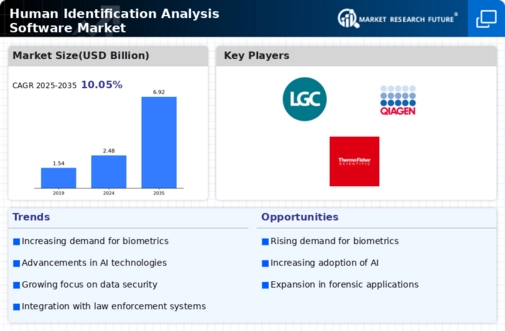Market Analysis
In-depth Analysis of Human Identification Analysis Software Market Industry Landscape
The Human Identification Analysis Software Market is experiencing dynamic shifts driven by technological advancements and increasing applications across various industries. This market revolves around software solutions designed for human identification purposes, catering to sectors such as law enforcement, healthcare, and immigration. Technological advancements stand out as one of the key factors that impact on market dynamics. Biometric technologies, for instance fingerprint recognition, face detection and DNA analysis have dramatically improved the accuracy and performance of human identification software. The market is highly driven by law enforcement sector. Human identification software improves studies as it helps to compare fingerprints, analyze facial characteristics and even profiling DNA. The rising demand for effective crime-solving tools has driven their acceptance. The healthcare is another important player in this market. Human identification software is used for patient ID, proper medical records and the prevention of identity fraud in health care systems. This application has been vital in ensuring data integrity and also improving patient safety. Human identification software serves as a focal point in light of the world’s attention to border security and immigration management. Biometric authentication, for example face recognition and fingerprint scanning is adopted widely in the border crossings as well as immigration checkpoints to identity an individual. The Human Identification Analysis Software Market is highly competitive. Key leaders are always innovating, to come up with more accurate and reliable solutions. To survive in the race, market leaders invest a lot of money on research and development as this is highly competitive. The evolving regulatory landscape further impacts the market dynamics. Governments across the world are coming up with regulations on how humans should use human identification software due to concerns of privacy as well ethics in practicing digital forensic. Adherence to the abovementioned regulations has become a key factor for market players. The globalization of business and the rise in cross-border activities have been propagated by the need for an easy human identification process. Due to the nature of organizations as global entities, demand for identification solutions which are interoperable and standardized has increased significantly causing changes in market dynamics. The complexity of human identification systems increases the threat to cyber security. The issue of protecting sensitive biometric data is a critical matter not only for the providers but also, as evident from this case study, end users. Thus the market dynamics are driven by continuous attempts to boost cybersecurity characteristics of these systems. The evolution of emerging technologies such as AI and machine learning is changing the market by integrating human identification software. People use intelligent algorithms in the processes of identification which makes them more accurate and faster than they could have been before. While the end-users require solutions tailor made for their unique needs, they also want products that can be easily scalable. The competitive advantage of market players offering flexible and scalable human identification software comes from the fact that organizations are looking for solutions which have the capabilities to change according to altering demands.






Leave a Comment